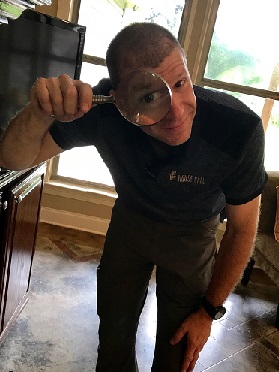As home inspection professionals, we are expected to provide our paying clients with enough information so they can make a more informed decision about whether or not to purchase a particular property. It’s an enormous responsibility, and one that every person that considers themselves a professional home inspector must take seriously.

Long ago, this was a difficult task to achieve, as the original home inspectors suffered the same problems that plague any fledgling industry: a lack of consistent rules by which to play the game. Whenever any group starts something new, the first few years are always thought of as “the wild west.” Lots of people under one umbrella, doing a variety of different things but calling themselves by the same moniker. In the 1980’s, many different people were doing “home inspections,” but there was such a big variety in what they were doing, it was hard to define exactly what is was that a home inspector did when they went to a home.
As the industry grew, and more practitioners entered the field, the need for some guidelines became apparent. The “wild west” soon gave way to a profession that was much more predictable, as industry groups, cities and states began to publish minimum standards to dictate exactly what a professional inspector had to do for their clients.
These standards of practice, as they would come to be called, provided guidelines for both inspector and client, allowing everyone involved to share an understanding of the job that was to be performed. The inspector knew what they were responsible for providing to their client, and the client knew exactly what they were paying for when they hired an inspector.
These minimum standards helped to “standardize” our fledgling industry, adding credibility to our profession while simultaneously helping to set the legal parameters by which a professional inspector would be judged. These new standards proved to be a win-win for everyone involved.
As the industry grew, it followed the well-worn and predictable path of every other industry around. Eventually, inspectors arrived on the scene who promised to provide their clients with more than the mandated minimums, and segmentation of the market began. These “rebels” discovered a fact that exists in every other industry:
There will always be customers who are willing to pay more in order to get more.
You can buy a car for about $14,000 that will get you from home to work and back again every day. You can also spend more, sometimes much more, in order to get a nicer vehicle with more “bells and whistles.” You can take a date for a burger, fries and drink at your local McDonald’s and be back on the road (in your $14,000 car) for less than $10. Or you could spend much more money at a four-star, white tablecloth restaurant, dining in comfort and style, all while making a better impression on your evening’s companion.
The choice is yours, bare minimum, way over the top, or somewhere in the middle. The vehicles all do the same thing: getting you from point A to point B. The meals all provide you with sustenance, satisfying your hunger and providing the calories your body needs to survive. They just do the same job in different ways and at different levels of quality.
The same holds true with a home inspection. Some inspectors provide a bare-bones product, giving exactly what their standards tell them to, and not an inch more. While other inspectors go above and beyond the call of duty, providing their clients with a much more comfortable ride and much nicer meal, often accompanied by the much higher price that such quality commands.
The big question that every inspector must face is what type of product do you want to provide? Are you happy being the Walmart of home inspections, offering bare bones service for the cheapest price, or would you prefer to be known as a higher-end option, providing those clients willing to pay more with a better quality offering?
There really is no right or wrong answer here. Your position in this argument is based on many different factors, and each of us must try to answer these questions as best we can in order to define our market position.
What is the quality and price of my local housing stock?
What type of competition is out there for my services?
How much experience do I have, and can I reasonably justify providing a higher end inspection product?
How many inspections do I really want to do each month?
Is my marketing attracting the type of clients who are willing to pay a higher price to get better quality?
Am I willing to walk away from lower quality clients in my drive to become known as a high-end provider?
Am I willing to go the extra mile for my customers, doing things that are above and beyond what’s required by the minimum standards?
Some inspectors are content in offering a basic service, complying with the minimum standards and never exceeding them, while other inspectors wouldn’t dream of not providing their clients with the most thorough inspection possible.
Where you choose to fall on this spectrum is a decision that only you can make.
Personally, I prefer to hang around at the top of the spectrum, providing my clients with an inspection product that greatly exceeds the minimums required by my state’s standards of practice. Unless it’s incredibly unsafe, I always walk the roof. I check every accessible item in the home, not just the “representative number” that’s required by the standards. I inspect for tempered safety glass in all required areas. I operate shut off valves, identify overflow drain discharge locations and light fireplaces. I run the installed washer and dryer and inspect detached sheds.
I go above and beyond the minimum standards in everything I do, and I charge accordingly. I market to higher-end Realtors and turn down jobs for those that I know are going to try to “nickel and dime” me on the price. I’m targeting higher-end clients who don’t bat an eye when it comes to paying for quality.
Those who spend the least and ask for the most before ordering will do the same thing after the sale.
Tim Ferris
I’ve been in the inspection business since 2000 and have been lucky enough to see my business mature and grow since starting out all those years ago. I wasn’t always in the position to target a higher-end clientele, but that goal was always in the works. Everything I’ve done since starting was planned with the end goal of working with quality clients who would appreciate a higher-end product.
This plan has taught me five things about the home inspection industry:
1) A higher quality inspection report minimizes future problems.
Because I need to work a little harder to provide my clients with a better inspection report, the chances of future problems occurring are dramatically less than they would be if I was providing a less-than-thorough inspection. To produce a better inspection report, it’s imperative that you do a better inspection.
2) More information in the report leads to fewer follow up questions.
I know exactly what questions the average client is going to ask about my findings, so I’ve worked to eliminate the follow up call/email and just provided the answers to those frequently asked questions in my report. Yes, it takes more time to be sure my inspection comments cover these things, but I’d rather work hard once to get the comments right in my report than to have to answer the same questions over and over again from each inspection client.
3) It’s much easier to inspect it now than to try to explain it away later.
Even after our best attempts to educate them, our clients are often clueless as to what we really do on an inspection. Rather than trying to explain why I’m not required to run the washing machine on an inspection, it’s simply easier for me to just run the washer. When my client is calling 2 days after they’ve moved in, wondering why I didn’t tell them that the hot water doesn’t work at their washer, it’s hard for them to fathom that an inspector isn’t required to check for proper functioning washer connections. After all, how hard is it really to turn on a washing machine during a home inspection?
4) Clients are your best (and worst) marketing tools.
With the advent of smart phones, everyone can instantly provide feedback that can raise up or crash down your business. Why give them a reason to bad-mouth you on social media? If you follow the old adage of under-promising and over-delivering, you’ll find that your clients are more than willing to promote your business. Whether it’s by providing you with a glowing Google review, singing your praises to their Realtor or letting their friends (who are about to buy a house) know about your services, a satisfied customer is always ready to tell the world how smart they were for choosing the best inspector available. Providing your clients with a product that exceeds their expectations is one of the easiest (and least expensive) marketing tools you have. Why not use it?
5) You can work less by giving more.
If you’re offering home inspections for $250 in an ill-advised attempt to “compete in your market,” you’ll have to do 4 different inspections to gross $1000. If you’re charging $500, it only takes 2 clients to get you to the same gross revenue. That means less work, less marketing, fewer chances that you’re dealing with problems (cancelled or rescheduled inspections, complaints, accidental damages, disgruntled sellers, etc.), and higher overall net revenue for your business. It’s hard to see a downside to being at the upper end of the pricing spectrum.
Some people will argue that by doing more than you’re required to by law, you’re opening yourself up to more liability. While I’m certain some compelling arguments can be made to support this point, the fact remains that there are many higher end inspectors out there who have been following this business model for years and are experiencing the numerous benefits of a higher-end clientele. It’s been my experience that when you go above and beyond the call of duty, your clients are a bit more forgiving when problems eventually arise. And let’s face it, it’s a house, problems will always come up. When something does eventually break on one of my clients’ homes, I’m much more likely to receive a call asking for some guidance than I am to be served with a certified letter requesting my presence in a court of law. The small investment that I made by providing my clients with better service and a higher quality product pays dividends far into the future.

As with anything we do in life, there is always the possibility that someone will try to take advantage of our generous nature. That’s why it’s a good idea to take some precautions when going past your standards. Include language in your inspection report explaining what the standards are and how they apply to the inspection. Also include language that explains that, while the inspector may report on items outside the scope of these standards as a service to their clients, this additional service in no way constitutes an inspection of those items and the information is being provided simply as a courtesy to your clients.
In every instance where you exceed the standards, it’s a good idea to include language recommending that any concerns that the client may have regarding these items be further investigated by a qualified tradesperson prior to the end of the inspection period. This language helps to define the limits of the inspection, as well as make sure that the client knows that they are getting something extra (outside the scope) in their inspection report.
It’s up to us to decide if we want to exceed the minimums in our business, and if so, how far past those minimums we want to go. Ultimately, the quality of our product will have an effect (positively or negatively) on our business and our bottom line.
Our goal isn’t to create a business that is as large as possible, but rather a business that bothers us as little as possible.
Tim Ferris
Why not give a little more to get a little more? Your clients, your agents, your bank account and your conscience will thank you.
I welcome all feedback (both positive and negative) on this post.
Please take a moment to leave a comment below. Thank you!
Want to be an Influencer in Your Field? Share This Post!
Thanks, Joe

